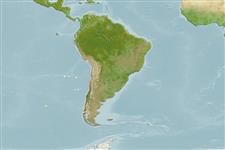Common names from other countries
Environment: milieu / climate zone / depth range / distribution range
Écologie
; profondeur 0 - 20 m (Ref. 101272). Temperate, preferred 18°C (Ref. 107945); 16°S - 47°S, 110°W - 70°W
Distribution
Pays | Zones FAO | Écosystèmes | Occurrences | Introductions
Southeast Pacific: Chile, Easter Island, and Peru. Subtropical to temperate.
Length at first maturity / Taille / Poids / Âge
Maturity: Lm ? range ? - ? cm Max length : 8.0 cm SHL mâle / non sexé; (Ref. 101426)
Common shell length is between 5 to 7 cm (Ref. 101426).
Life cycle and mating behavior
Maturité | Reproduction | Frai | Œufs | Fécondité | Larves
Members of the class Bivalvia are mostly gonochoric, some are protandric hermaphrodites. Life cycle: Embryos develop into free-swimming trocophore larvae, succeeded by the bivalve veliger, resembling a miniature clam.
Urban, H.J. and B. Campos. 1994. (Ref. 75339)
Statut dans la liste rouge de l'IUCN (Ref. 130435: Version 2024-1)
statut CITES (Ref. 108899)
Not Evaluated
Not Evaluated
Utilisations par l'homme
Pêcheries: commercial
FAO - pêcheries: landings, species profile | FishSource | Sea Around Us
Outils
Sources Internet
Estimates based on models
Résilience
Milieu, temps minimum de doublement de population : 1,4 à 4,4 années (K=0.17-0.25).
Vulnérabilité
Low to moderate vulnerability (35 of 100).
